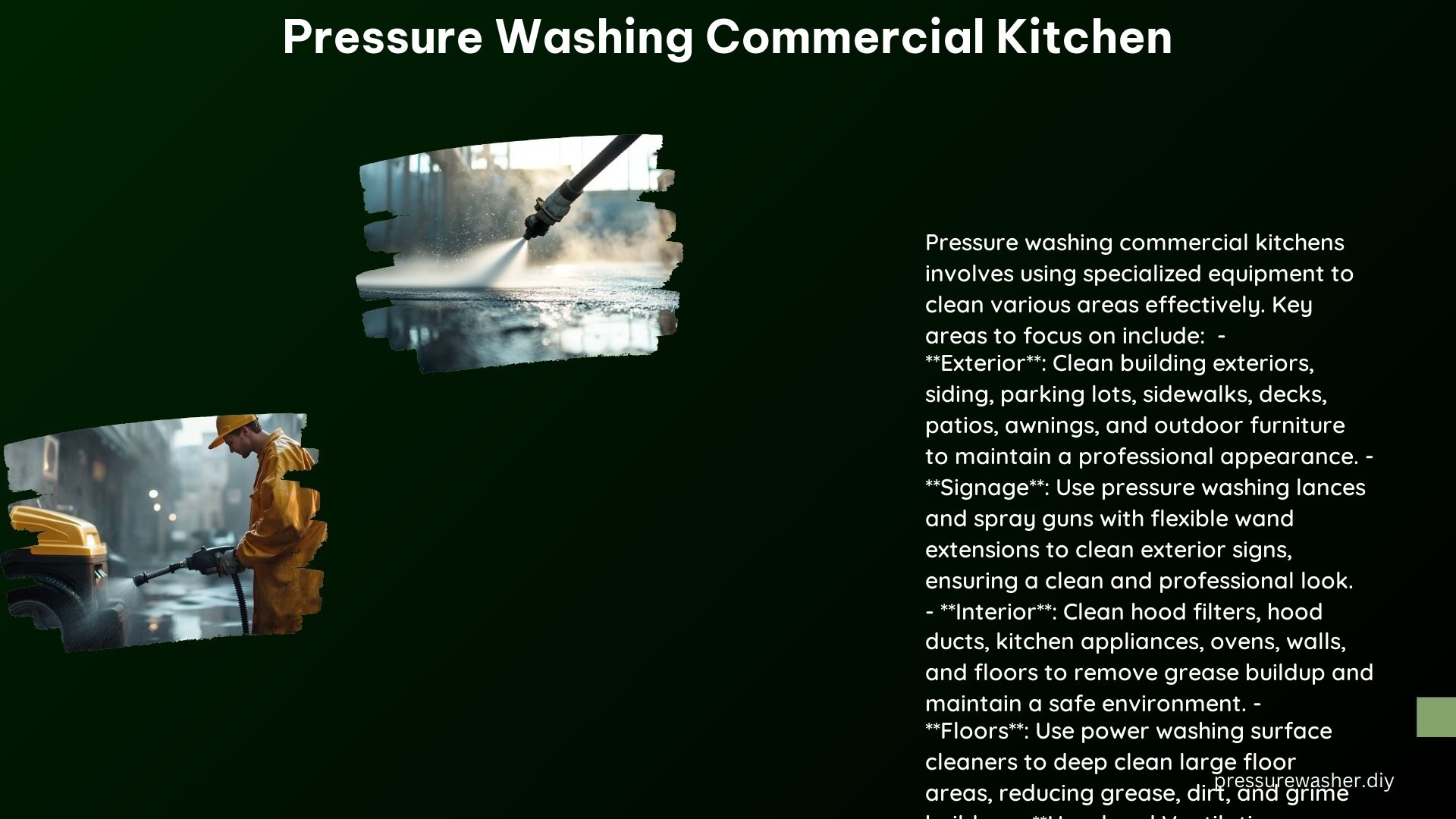Maintaining a clean and efficient commercial kitchen is crucial for the food service industry. Pressure washing is an essential tool for achieving this goal, as it effectively removes grease, dirt, and grime from various surfaces and equipment. This comprehensive guide will delve into the specific cleaning requirements, frequency, and benefits of using pressure washing in commercial kitchens, as well as provide technical specifications and DIY tips for a successful pressure washing operation.
Specific Cleaning Requirements
Exterior Cleaning
Pressure washers can be used to clean a wide range of exterior surfaces in a commercial kitchen, including building exteriors, parking lots, sidewalks, decks, patios, awnings, entryways, and outdoor furniture. This helps maintain a clean and professional appearance, which is crucial for customer perception and satisfaction.
Kitchen Equipment and Appliances
Hot water pressure washers are highly effective for cleaning kitchen equipment, food prep areas, and appliances, especially those with heavy grease buildup. The high-pressure water and heat can effectively break down and remove stubborn grease and grime, ensuring a thorough and efficient cleaning process.
Hood Filters and Ventilation Systems
Power washing is essential for cleaning hood filters, hood ducts, and ventilation systems in commercial kitchens. Removing the built-up grease and debris from these critical components helps prevent kitchen fires and maintain a safe working environment.
Floors and Mats
Daily cleaning of kitchen floors and rubber mats is necessary to avoid slipping hazards and reduce the accumulation of bacteria and grime. Pressure washing is an effective method for quickly and thoroughly cleaning these surfaces, ensuring a safe and hygienic workspace.
Frequency of Pressure Washing

Daily Cleaning
To maintain a safe and clean environment, it is recommended to perform daily cleaning of kitchen floors and rubber mats using a pressure washer. This helps remove any spills, debris, or grime that may have accumulated throughout the day.
Regular Deep Cleaning
In addition to daily cleaning, regular deep cleaning with a power washer is necessary to remove the grease, dirt, and grime that can build up on floors, equipment, and other surfaces over time. The frequency of these deep cleaning sessions may vary depending on the volume of kitchen activity and the specific needs of the establishment, but they are crucial for maintaining a high level of cleanliness and safety.
Benefits of Pressure Washing
Efficiency
Pressure washing significantly reduces the time and effort required for cleaning, increasing overall efficiency and speeding up production in the kitchen. The high-pressure water and specialized cleaning tools can tackle tough grime and grease much more quickly than manual scrubbing.
Safety
Pressure washing plays a vital role in maintaining kitchen safety by removing grease buildup from hood filters and ventilation systems. This helps prevent the risk of kitchen fires, which can have devastating consequences for the business and its employees.
Cleanliness
Pressure washing ensures a clean and professional appearance, both inside and outside the restaurant. This is critical for customer confidence and satisfaction, as a well-maintained and hygienic kitchen environment is a key factor in the overall dining experience.
Cost-Effectiveness
Pressure washing is a cost-effective method for cleaning large areas and equipment, reducing the need for manual labor and the use of harsh chemicals. This can lead to significant cost savings for the business over time.
Technical Specifications
Hot Water Pressure Washers
For cleaning kitchen equipment and appliances with heavy grease buildup, hot water pressure washers are the recommended choice. The combination of high-pressure water and heat helps to effectively break down and remove stubborn grease and grime.
Pressure Washer PSI
A minimum of 4350 PSI (pounds per square inch) is recommended for pressure washers used in commercial kitchens, as this level of pressure is necessary for removing graffiti and heavy grease buildup.
Specialized Tools
In addition to the pressure washer itself, specialized tools like power washing lances and spray guns with flexible wand extensions are necessary for cleaning hard-to-reach areas, such as restaurant signage or the underside of kitchen equipment.
DIY Tips
Choose the Right Pressure Washer
When selecting a pressure washer for commercial kitchen use, it is essential to consider factors such as PSI, temperature, and flow rate to ensure the equipment is suitable for the specific cleaning requirements.
Use Appropriate Detergents
Utilizing detergents specifically designed for commercial kitchen cleaning is crucial for effective grease removal and maintaining safety standards. These specialized detergents are formulated to work in conjunction with the high-pressure water to break down and remove stubborn grease and grime.
Follow Safety Precautions
When using pressure washers in a commercial kitchen, it is vital to adhere to all safety precautions. This includes wearing appropriate personal protective equipment (PPE), such as safety goggles, gloves, and non-slip footwear, as well as ensuring proper ventilation and following the manufacturer’s instructions for the pressure washer.
By following the guidelines and recommendations outlined in this comprehensive guide, commercial kitchen operators can effectively leverage the power of pressure washing to maintain a clean, efficient, and safe working environment, ultimately enhancing the overall customer experience and the success of their business.
